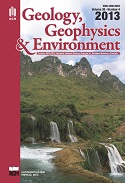Characterization of near-surface sediments based on Electrical Resistivity Tomography measurements in the vicinity of the Wawel Hill (Krakow, Poland)
DOI:
https://doi.org/10.7494/geol.2013.39.4.351Keywords:
applied geophysics, electrical resistivity tomography, near-surface, Wawel HillAbstract
The Electrical Resistivity Tomography (ERT) method was applied at the SW foot of the Wawel Hill was applied. The survey was carried out along five survey lines (P1–P5), 50 m long each. The Wenner alpha array with spacing a = 0.5 m, 1.0 m, 1.5 m, 2.0 m, 2.5 m, 4.0 m, 5.5 m, 7.5 m, and 10.0 m was used. The basic electrode spacing was 0.5 m. In apparent resistivity contours and sections we can distinguish two zones, which have noticeably different resistivity values. The low resistivity zone dominates in the deeper part of the section on all survey lines, especially on the profiles located in the close neighbourhood of the Vistula River. The relative high resistivity zone is probably the effect of complex local geology, as well as the influence of the limestone of the Wawel Hill. Based on ERT inversion results, three resistivity zones were distinguished. Then the probable lithological or/and anthropogenic character was assigned to them. The shallowest zone has the thickness of about 0.5 m and results probably from accumulation of weathered limestone fragments derived from the Wawel Hill. It may be that high resistivity zones have anthropogenic character. Below, a zone of water-bearing sands was recorded, which may result from redevelopment and reclamation of this area. Thickness of this zone increases towards the Vistula River. Another zone, which can be identified with limestone, was identified on survey lines P4 and P5. This could also be result of accumulation of the calcareous debris for the purpose of planation of the area. In order to generalize and simplify the characterization of the quaternary sediments, 1D interpretation was made. The method allows us to estimate the depth of groundwater, which in that place is about 5 m.Downloads
References
Bobachev A., 2001. IPI2win Resistivity Sounding Interpretation software. Moscow State University IP2Win User's Guide.
Dahlin T., 1996. 2D resistivity surveying for environmental and engineering applications. First Break, 14,7,275-283.
Georgaki I., Soupios P., Sakkas N., Ververidisa K., Trantasa E., Vallianatos F. & Manios T., 2008. Evaluating the use of electrical resistivity imaging technique for improving CH4 and CO2 emission rate estimations in landfills. Science of the Total Environment, 389, 522-531.
Keller G.V. & Frischknecht F.C. 1966. Electrical Methods in Geophysical Prospecting. Pergamon Press, Oxford.
Kleczkowski A., 1964. Zarys warunków hydrogeologicznych na terenie miasta Krakowa. Sprawozdania z Posiedzeń Komisji Naukowych Polskiej Akademii Nauk, Oddział w Krakowie, styczeń-marzec 1964, 22.
Kmietowicz-Drathowa I., 1964. Rys budowy geologicznej czwartorzędu okolic Krakowa. Sprawozdania z Posiedzeń Komisji Naukowych Polskiej Akademii Nauk, Oddział w Krakowie, 269-274.
Koefoed O., 1979. Geosounding Principles. Elsevier, Amsterdam.
Loke M.H., 2003. Rapid 2D resistivity & IP inversion using least-squares method. Geotomo Software. Manual.
Loke M.H., 2010. Tutorial: 2-D and 3-D electrical imaging surveys. Geotomo Software.
Loke H., Ackworth I. & Dahlin T., 2003. A comparison of smooth and blocky inversion methods in 2D electrical imaging surveys. Exploration Geophysics, 34, 182-187.
Misiewicz K., 1998. Metody geofizyczne w planowaniu badań wykopaliskowych. PPH GROSS, Warszawa.
Mościcki W.J. & Antoniuk J., 1998. Metoda obrazowania elektrooporowego (resistivity imaging). Przykład badań dla celów geologiczno-inżynierskich. Materiały V Konferencji Naukowo-Technicznej: Geofizyka w geologii, górnictwie i ochronie środowiska, Kraków, 315-325.
Mościcki W.J., 2008a. 2D resistivity imaging of an anisotropic 3D body - results of a laboratory experiment. Near Surface 2008, 14th European Meeting of Environmental and Engineering Geophysics, 15-17 September 2008, Krakow, Poland. Extended Abstracts & Exhibitors' Catalogue, P23.
Mościcki W.J., 2008b.The application of resistivity investigations in archaeology - two case studies from Kraków. Poland. Near Surface 2008, 14th European Meeting of Environmental and Engineering Geophysics, 15-17 September 2008, Krakow, Poland. Extended Abstracts & Exhibitors' Catalogue, P58.
Rotter A. & Szelerewicz M., 2005. Smocza Jama w Wawelu: Przewodnik. Wydawnictwo Karpaty - Andrzej Łączyński, Kraków.
Schrott L. & Sass O., 2008. Application of field geophysics in geomorphology, advances and limitations exemplified by case studies. Geomorphology, 93, 55-73.
Sechman H., Mościcki W.J. & Dzieniewicz M., 2013. Pollution of near-surface zone in the vicinity of gas wells. Geoderma, 197, 193-204.
Tyczyńska M., 1967. Rzeźba i budowa geologiczna terytorium miasta Kraków. Folia Geographica, Series Geographica - Physica, Środowisko geograficzne terytorium miasta Krakowa, 1, 19-27.
Unesco World Heritage List, [on-line:] http://whc.unesco.org/en/list/29 [access: December 2013].
Downloads
Published
Issue
Section
License
Authors have full copyright and property rights to their work. Their copyrights to store the work, duplicate it in printing (as well as in the form of a digital CD recording), to make it available in the digital form, on the Internet and putting into circulation multiplied copies of the work worldwide are unlimited.
The content of the journal is freely available according to the Creative Commons License Attribution 4.0 International (CC BY 4.0)










